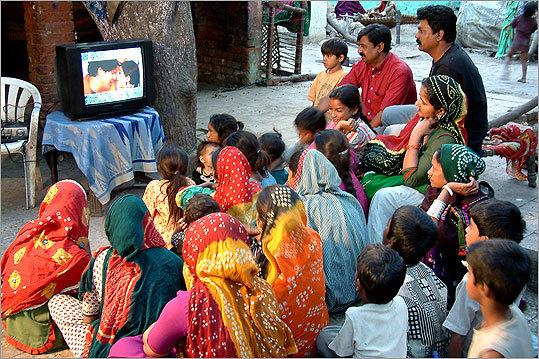Indian Women Learn To Read Watching Music Videos
 Tiny, sun-soaked Khodi on the western coast of India’s Gujarat state is the kind of village where cattle still plough the fields and women fill clay pots with water from the village well.
Tiny, sun-soaked Khodi on the western coast of India’s Gujarat state is the kind of village where cattle still plough the fields and women fill clay pots with water from the village well.In the past few years, however, the town has been changing: Thatched mud huts are slowly giving way to sturdy, single-story concrete blocks; farmers conduct their business on cellphones. The state buses, which until a decade ago were only filled with men, are now crammed with women. Enrollment in the local school has soared.
These changes can be attributed partly to India’s recent economic liberalization, which has raised incomes and brought unprecedented growth across the country. But in Khodi, there’s another, more unlikely contributor: the soaring local literacy rate, courtesy of music videos.
Every Sunday in villages across India, groups of people — an assortment of turbaned men, sari-clad women, and gap-toothed children — gather around old television sets to watch their favorite Bollywood film stars sing and dance in song videos culled from movies. These song shows, a popular component of mainstream television programming, are often the only way rural populations can see the stars or access the latest films.
Nine years ago, India’s national television network decided to introduce karaoke-style subtitles to these programs — not in a foreign language, but in Hindi, the language the stars were singing in. The first state to broadcast the subtitles was Gujarat. People in Khodi, and in the rest of the state, saw the captions as an opportunity to sing along with the songs.
They began paying attention to the moving strip of lyrics at the bottom of the screen. Often, they would copy the words on paper, going back to them after the show was over. And as they did, the reading level in Khodi slowly improved.
According to Hema Jadvani, a researcher who has been studying the effects of the subtitles on Khodi, newspaper reading in the village has gone up by more than 50 percent in the last decade. Her research also shows that the village’s women, who can now read bus schedules themselves, are more mobile, and more children are opting to stay in school.
India’s public karaoke-for-literacy experiment is the only one of its kind in the world. Technically known as same-language subtitling, or SLS, it manages to reach 200 million viewers across 10 states every week. In the last nine years, functional literacy in areas with SLS access has more than doubled. And the subtitles have acted as a catalyst to quadruple the rate at which completely illiterate adults become proficient readers.
In the fight against poverty, this is big news. Development organizations the world over have long been grappling with the challenge of increasing literacy, which is linked not only to economic growth, but to better health, greater gender equality, and a more transparent political process.
Against this background, the apparent effectiveness of subtitles — along with their low cost, only 1 cent per person per year — has attracted the attention of academics and educators. Viewers in India have shown reading improvement after watching just eight hours of subtitled programming over six months; conventional literacy teaching methods typically require much more time and far greater resources to achieve the same results.
Click here to read the full story:
By Riddhi Shah
The Boston Globe
Photo Credit:
Jaydeep Bhatt
Related Links:
More About India on AWR
Nine years ago, India’s national television network decided to introduce karaoke-style subtitles to these programs — not in a foreign language, but in Hindi, the language the stars were singing in. The first state to broadcast the subtitles was Gujarat. People in Khodi, and in the rest of the state, saw the captions as an opportunity to sing along with the songs.
They began paying attention to the moving strip of lyrics at the bottom of the screen. Often, they would copy the words on paper, going back to them after the show was over. And as they did, the reading level in Khodi slowly improved.
According to Hema Jadvani, a researcher who has been studying the effects of the subtitles on Khodi, newspaper reading in the village has gone up by more than 50 percent in the last decade. Her research also shows that the village’s women, who can now read bus schedules themselves, are more mobile, and more children are opting to stay in school.
India’s public karaoke-for-literacy experiment is the only one of its kind in the world. Technically known as same-language subtitling, or SLS, it manages to reach 200 million viewers across 10 states every week. In the last nine years, functional literacy in areas with SLS access has more than doubled. And the subtitles have acted as a catalyst to quadruple the rate at which completely illiterate adults become proficient readers.
In the fight against poverty, this is big news. Development organizations the world over have long been grappling with the challenge of increasing literacy, which is linked not only to economic growth, but to better health, greater gender equality, and a more transparent political process.
Against this background, the apparent effectiveness of subtitles — along with their low cost, only 1 cent per person per year — has attracted the attention of academics and educators. Viewers in India have shown reading improvement after watching just eight hours of subtitled programming over six months; conventional literacy teaching methods typically require much more time and far greater resources to achieve the same results.
Click here to read the full story:
By Riddhi Shah
The Boston Globe
Photo Credit:
Jaydeep Bhatt
Related Links:
More About India on AWR